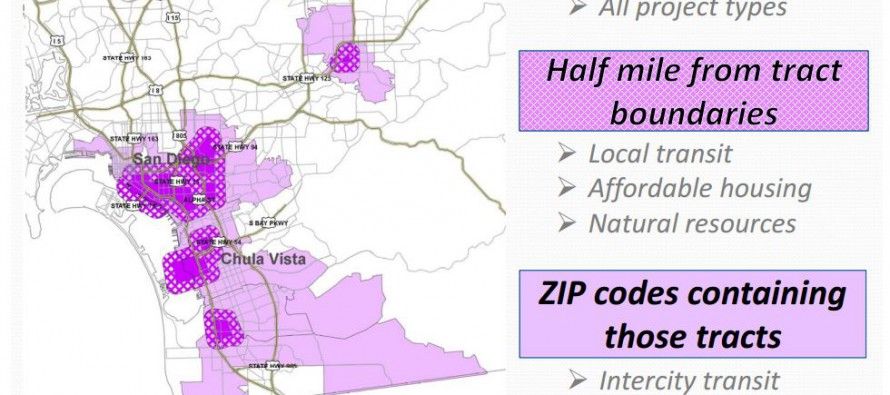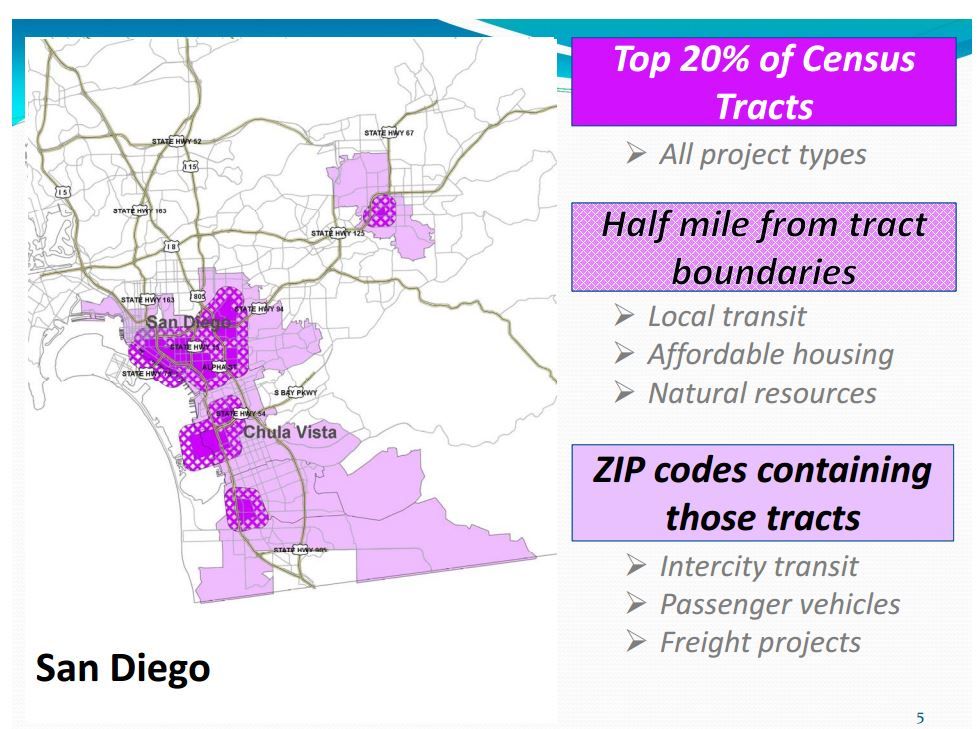Counties vie for ‘disadvantaged’ cap-and-trade bucks

 In the fictional town of Lake Woebegon, all of the children are above average. But in the real world of California, all of the counties are disadvantaged.
In the fictional town of Lake Woebegon, all of the children are above average. But in the real world of California, all of the counties are disadvantaged.
Or so it seemed at a recent California Air Resources Board meeting as officials from all over the state poor-mouthed their districts to gain a share of cap-and-trade funds set aside for “disadvantaged communities.”
Cap and trade is one of the main greenhouse-gas-reduction components in the implementation of AB32, the Global Warming Solutions Act of 2006. It’s projected to raise $832 million in the current fiscal year that will be doled out to various state agencies.
Senate Bill 535, passed in 2012, mandates at least 25 percent of cap-and-trade spending must benefit disadvantaged communities, with at least 10 percent going to projects located in those communities.
CARB, which implemented and administers the cap-and-trade program, identifies “disadvantaged communities” based on their California Environmental Protection Agency CalEnviroScreen score. Each of the state’s 8,000 census tracts are scored from 0 (least disadvantaged) to 100 (most disadvantaged), based on 12 pollution and environmental factors and seven population characteristics and socioeconomic factors.
The most disadvantaged communities are generally those with the highest levels of pollution and the poorest population. They are predominantly in the agricultural Central Valley from Sacramento to Bakersfield, along with urban pockets in the Bay Area, Los Angeles and San Diego.
“CalEnviroScreen shows clearly what we in the San Joaquin Valley know all too well: that many of our communities are among the most disadvantaged in the state,” said Fresno Mayor Ashley Swearengin, as quoted in a CalEPA press release. “By reinvesting funds in areas of the state with high pollution levels, California is demonstrating its commitment to a cleaner and more prosperous future for all.”
In the November election, she is running for state controller as a Republican against Democrat Betty Yee, a member of the state Board of Equalization.
Angry
But not so fast, said numerous officials and advocates who spoke at CARB’s recent hearing on the issue. Particularly angry was CARB member and San Diego County Supervisor Ron Roberts, who produced a map:
 Color code:
Color code:
- White indicates an area is not that disadvantaged
- Dark purple marks the more disadvantaged areas.
- Light purple indicates intermediate areas.
Roberts didn’t like the CalEnviroScreen white coloration on the southern end of his county near the Mexican border. “Where those two freeways come together in that white zone is the busiest border crossing in the world,” he said.
Interruption
As Roberts was talking, CARB Chairwoman Mary Nichols interrupted, “You don’t have a hard time convincing me. You need to go take this argument to CalEPA.”
“The fact that’s not a bright purple, it is disadvantaged in every way, shape, or form,” said Roberts.
Nichols again interrupted, “All I can tell you is –“
“Let me finish,” said Roberts. “The EnviroScreen may be good for some things, but this is being missed. That whole area should be bright purple, not just the white. The fact that it’s not, should signal somebody that the model we have is not accounting for what’s happening on the ground. There is no way that I can support something that basically ignores the situation like this.
“That’s one of our most impacted areas in the whole county, for certain, and it’s one of our lowest income areas. This is a miscarriage of justice. And you talk about environmental justice, and there is none in that map right there.”
Northern California
There is also disadvantaged disgruntlement from officials at the other end of the state. Alan Abbs, the Tehama County air pollution control officer, is concerned his county’s census tracts are in the 25-30 percent most disadvantaged ranking, although the cutoff for funding might be at the 20 percent most disadvantaged level.
“Tehama County as a whole has a population with a median household income 33 percent below the state median,” Abbs told the board. “We have the highest asthma rates in the north state. And like any county in California, we have pockets that are significantly less well off than other pockets. So at the outset, I would urge the board to consider going beyond the 20 percent level when you’re looking at disadvantaged communities.
“When we look in the future about how rural areas of California are going to be receiving funds through cap and trade, especially when fuels get added into cap and trade [starting in 2015], I think we’ll find out a lot of rural areas of California are going to be [left] out, even though the residents in those areas are going to be paying into the program through higher fuel costs.”
Also concerned that the CalEnviroScreen rankings may not provide the whole picture, particularly in rural areas not in the Central Valley, was Tehama County Supervisor Bob Williams, representing the Rural County Representatives of California.
“CalEnviroScreen multiplies pollution burdens by the social and economic characteristics of the community, basically eliminating areas of the state with good air quality from being defined as disadvantaged communities, no matter their socioeconomic status,” said Williams.
“Using strictly the CalEnviroScreen as a source for recognition could potentially eliminate a minimum of counties from consideration, including counties such as Lake, Modoc, Plumas, and Lassen. If you’ve been to those counties, you would be hard pressed to deny they have disadvantaged areas.
“RCRC recommends that additional flexibility be allowed so local jurisdictions can demonstrate that a community smaller than a census tract can meet the definition of a disadvantaged community. Rural areas cannot compete in many AB32 programs because projects usually cost more to complete in more remote areas. Being excluded from the disadvantaged community designation all but eliminates these counties from access to funds.”’
Sympathetic
Nichols was sympathetic to their concerns. “We do understand this issue about rural areas, which undoubtedly are among the poorest of areas within the state of California, but are not the ones that fit the criteria of being impacted the most in terms of multiple sources of pollution,” she said.
“And we agree that it’s not just an issue of fairness. It’s an issue of addressing opportunities that are there to do things that could ultimately benefit all of us when it comes to reducing greenhouse gas emissions. So we want to make sure that there is a way to appropriately recognize and make sure there are funds flowing to rural communities in the overall AB32 cap-and-trade spending program.”
But advocates for poor urban areas aren’t keen on spreading the disadvantaged money around to less disadvantaged areas. They want the most disadvantaged communities, particularly those with minority populations, to get most of the money.
“I think all of us here understand that historically low-income communities of color have been disproportionately burdened with pollution, which remains true today,” said Bill Magavern with the Coalition for Clean Air. “So we have the opportunity now to go a little ways towards redressing that inequity, that environmental injustice, with some of the funds that are available.”
Monika Shankar, representing Physicians for Social Responsibility-Los Angeles, argued for “a ranking system to prioritize investments in communities with the greatest needs. For example, many of the census tracts in the top 5 percent score markedly worse than the next set of census tracts in the top 6 to 25 percent. And we need to be cognizant of that.”
Also in favor of concentrating the money where it’s needed most was Marybelle Nzegwu, a Public Advocates attorney representing the SB535 Coalition.
“We would like to see the guidelines at least provide guidance that scoring and ranking should prioritize certain types of projects, should prioritize projects that benefit the most disadvantaged communities, should also prioritize projects that provide the most benefits in the most significant way,” she said.
CARB voted 9-1 (with Roberts voting no) to adopt the disadvantaged communities spending guidelines outlined in their staff report. They also agreed to send a message to CalEPA that they feel there are some discrepancies in the CalEnviroScreen map ratings they would like addressed.
Related Articles
Bill aims to curb human trafficking
When Angela Guanzon was offered the opportunity to leave the Philippines and work in the United States, she felt like
Anti-fracking fervor builds in CA even as it lifts U.S. economy, stature
Anti-fracking sentiment in California continues to build, and we’re likely to see a spate of local moratoriums aimed at blocking
Polluters Welcome In CA?
Katy Grimes: The California Air Resources Board will be giving away free carbon permits to big oil companies, according to




